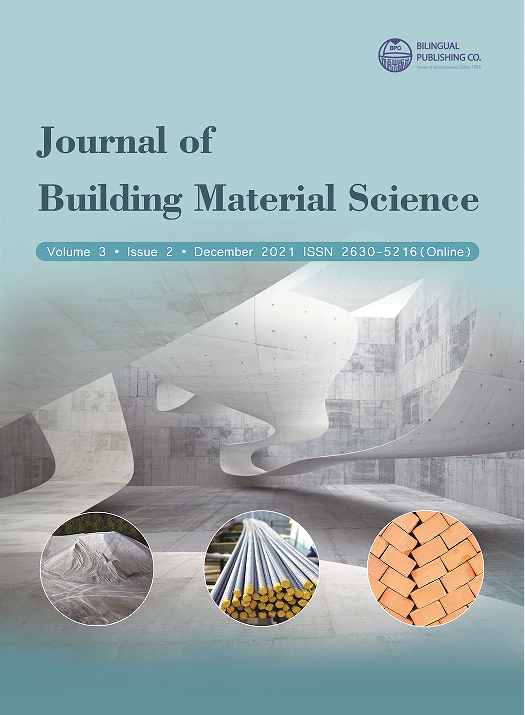-
1740
-
1262
-
1261
-
1151
-
1090
New Approach and Alternate Criterion for Heat-transfer Analysis of Building Walls and Its Applications
DOI:
https://doi.org/10.30564/jbms.v3i2.3103Abstract
Energy consumed by buildings accounts for approximately one-third of the total energy consumption of the society. Moreover, energy systems employed in buildings emit hazardous pollutants, such as, NOx, PM2.5 and CO2, into the environment. Consequently, increasing the energy efficiency of buildings constitutes an important problem concerning the field of building-energy and environment conservation. Thermal resistance and capacitance are two important thermophysical properties of building walls significantly impacting their heat-transfer performance. Traditional theories concerning these properties, however, face certain limitations: (1) the concept of thermal resistance is only valid for one-dimensional, steady heat conduction without existence of an internal heat source; (2) thermal resistance and capacitance are relevant, and can, therefore, not be used to analyze heat-transfer and storage performance, respectively, of building walls. Based on the entransy-dissipation-based impedance theory, a new approach towards realization of heat-transfer analysis and optimization has been proposed in this study. The weightiness of thermal resistance and capacitance with regard to heat-transfer performance has been described along with deduction of the corresponding substitutional relation via illustrative examples. The proposed approach has been demonstrated to effectively overcome aforementioned limitations of building energy conservation problems.Keywords:
Heat transfer, Thermal resistance, Capacitance, Entransy, ImpedanceReferences
[1] Asan H. Investigation of wall’s optimum insulation position from maximum time lag and minimum decrement factor point of view. Energy and Buildings 2000; 32: 197-203.
[2] Asan H. Numerical computation of time lags and decrement factors for different building materials. Energy and Buildings 2006; 41: 615-620.
[3] del Coz Dı´az JJ, Garcı´a Nieto PJ, Betego´n Biempica C, Prendes Gero MB. Analysis and optimization of the heat-insulating light concrete hollow brick walls design by the finite element method. Applied Thermal Engineering 2007; 27: 1445-1456.
[4] del Coz Dı′az JJ, Garcı′a Nieto PJ, Sua′rez Sierra JL, Pen˜uelas Sa′nchez I. Non-linear thermal optimization and design improvement of a new internal light concrete multi-holed brick walls by FEM. Applied Thermal Engineering 2008; 28: 1090-1100.
[5] Bouchair A. Steady state theoretical model of fired clay hollow bricks for enhanced external wall thermal insulation. Building and Environment 2008; 43: 1603-1618.
[6] Li LP, Wu ZG, Li ZY, He YL, Tao WQ. Numerical thermal optimization of the configuration of multi-holed clay bricks used for constructing building walls by the finite volume method. International Journal of Heat and Mass Transfer 2008; 51: 3669-3682.
[7] Guo ZY, Zhu HY, Liang XG. Entransy-a physical quantity describing heat transfer ability. International Journal of Heat and Mass Transfer 2007; 50: 2545-2556.
[8] Chen Q, Zhu HY, Pan N, Guo ZY. An alternative criterion in heat transfer optimization. Proceedings of the Royal Society A-Mathematical Physical &Engineering Sciences 2011; 467: 1012-1028.
[9] Chen Q, Wang MR, Pan N, Guo ZY. Optimization principles for convective heat transfer. Energy 2009; 34: 1199-1206.
[10] Chen L, Chen Q, Li Z, Guo ZY. Optimization for a heat exchanger couple based on the minimum thermal resistance principle. International Journal of Heat and Mass Transfer 2009; 52: 4778-4784.
[11] Guo ZY, Liu XB, Tao WQ, Shah RK. Effectiveness–thermal resistance method for heat exchanger design and analysis. International Journal of Heat and Mass Transfer 2010; 53: 2877-2884.
[12] Shah RK, Skiepko T. Entropy generation extrema and their relationship with heat exchanger effectiveness–number of transfer unit behavior for complex flow arrangements. Journal of Heat Transfer; Transactions of the ASME 2004; 126: 994-1002.
[13] Wu J, Cheng XT. Generalized thermal resistance and its application to thermal radiation based on entransy theory. International Journal of Heat and Mass Transfer 2013; 58: 374-381.
[14] Chen Q, Yang KD, Wang MR, Pan N, Guo ZY. A new approach to analysis and optimization of evaporative cooling system I: Theory. Energy 2010; 35: 2448-2454.
[15] Chen Q, Pan N, Guo ZY. A new approach to analysis and optimization of evaporative cooling system II: Applications. Energy 2011; 36: 2890-2898.
[16] Zhang T, Liu XH, Zhang L, Jiang Y. Match properties of heat transfer and coupled heat and mass transfer processes in air-conditioning system. Energy Conversion and Management 2012; 59: 103-113.
[17] Chen L, Chen Q, Li Z, Guo ZY. Moisture transfer resistance method for liquid desiccant dehumidification analysis and optimization, Chinese Science Bulletin 2010; 55: 1445-1453.
[18] Xu YC, Chen Q. An entransy dissipation-based method for global optimization of district heating networks. Energy and Buildings 2012; 48: 50-60.
[19] Zhang Y, Chen Q, Zhang YP, Wang X. Exploring buildings’ secrets: The ideal thermophysical properties of a building’s wall for energy conservation. International Journal of Heat and Mass Transfer 2013; 65: 265-273.
[20] Zeng RL, Wang X, Di HF, Jiang F, Zhang YP. New concepts and approach for developing energy efficient buildings: ideal specific heat for building internal thermal mass. Energy and Buildings 2011; 43: 1081-1090.
[21] Zhang Y, Zhang YP, Wang X, Chen Q. Ideal thermal conductivity of a passive building wall: Determination method and understanding. Applied Energy 2013; 112: 967-974.
[22] ASHRAE. Handbook Fundamentals. SI Edition, Atlanta: American Society of Heating, Refrigerating and Air-Conditioning Engineers, 2009.




 Yu Zhang
Yu Zhang





